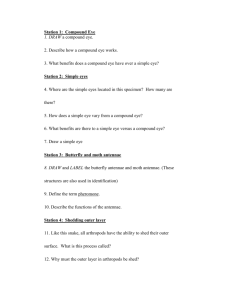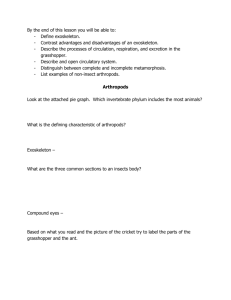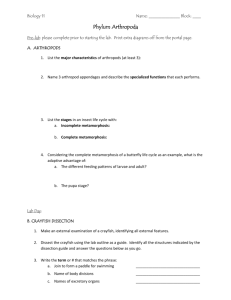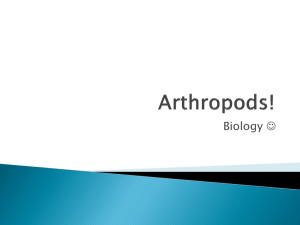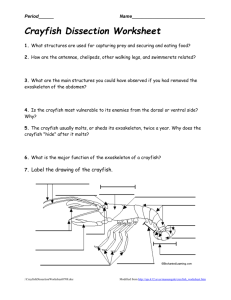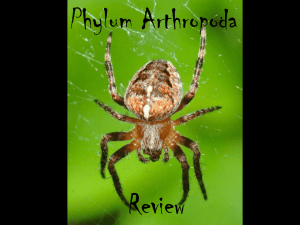Unit 6 Review #2 KEY - Mr. Lesiuk
advertisement
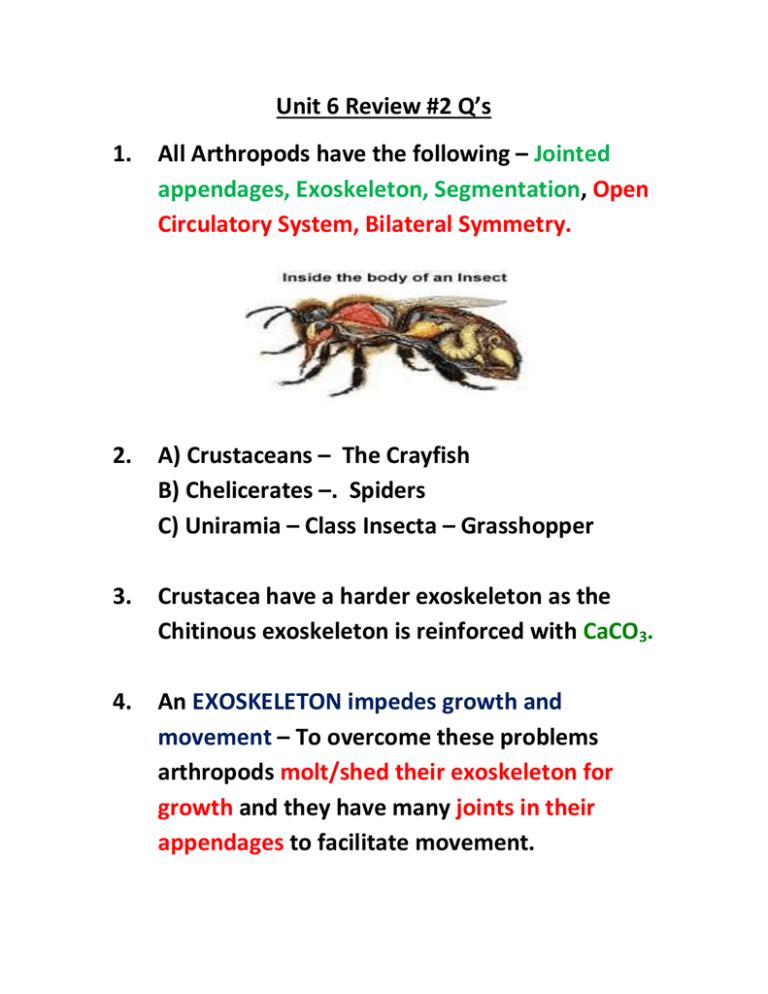
Unit 6 Review #2 Q’s 1. All Arthropods have the following – Jointed appendages, Exoskeleton, Segmentation, Open Circulatory System, Bilateral Symmetry. 2. A) Crustaceans – The Crayfish B) Chelicerates –. Spiders C) Uniramia – Class Insecta – Grasshopper 3. Crustacea have a harder exoskeleton as the Chitinous exoskeleton is reinforced with CaCO3. 4. An EXOSKELETON impedes growth and movement – To overcome these problems arthropods molt/shed their exoskeleton for growth and they have many joints in their appendages to facilitate movement. 5. The waxy coating is the CUTICLE and it reduces water loss. 6. Appendages are any key structures that project outward from the main trunk of the body. These include specialized appendages for : Walking and Jumping (legs), Flight (wings) Eating (palps,maxillipeds) Reproduction (clasping and sperm transfer), Sensing (antennae) and Breathing (gills off walking legs). 7. Arthropods have an open circulatory system, so the heart pumps blood out into an open hemocoel rather than through a closed network of blood vessels. In an annelid we saw a closed circulatory system, where blood was pumped around the body but the blood stayed inside blood vessels. 8. Being small in size has allowed insects to efficiently use an open circulatory system, efficiently use an exoskeleton, hide and quickly move. Small size has increased their overall fitness for survival. Large arthropods require a very large heavy exoskeleton, one which would be difficult for movement. The largest arthropods are found in the ocean, because the buoyancy of water helps them move easily. 9. Insects are the most successful of all animals due to the fact that they are very mobile as they possess small body size and the majority can fly, they have rapid life cycles to allow for great reproductive rate, they also show amazing diversity due to ability to adapt to all kinds of niches. Classes of Arthropods 1. Uniramia – Unbranched appendages (Class Insecta) One pair of antennae, Three pairs of legs and three body regions and usually two pairs of wings. Crustacea – Two pair of antennae, Exoskeleton reinforced with CaCO3 and all have mandibles for eating. Chelicerata – (Class Arachnida) No antennae, two body regions (cephalothorax and abdomen) and Chelicera (fang-like structures). 2. Typically, compound eyes, simple eyes (ocelli), palps, antennae, sensory bristles, a tympanum (eardrum). CRAYFISH 3. A cephalothorax is a region that consists of a fused head and thorax. 4. The carapace is a dorsal plate-like shell of exoskeleton over the anterior end of a crab, or crayfish to provide more solid protection of vital organs. 5. In Crustacea, the exoskeleton is Chitin (a carbohydrate chemical) and CaCO3. 6. A Cheliped is used for defense and for capturing food and crushing it. 7. The crayfish abdomen has 6 segments, 7 if including the Telson. BACK SIDE : 8. Gastric Mill 9. Digestive glands secrete enzymes to chemically break down food. 10. Anus is under the Telson. 11. Crayfish brain is located just above the esophagus which gives rise to a ventral nerve cord. 12. A) Green glands B) Antennules C) Rostrum D) 1st pair of swimmerets on male E) Gastric Mill F) Mandibles 13. Statocysts are found on antennules (shorter antennae) and they are used for sense of balance these shorter antennules are also branched (biramous). The longer antennae are not branched and they are more specialized for touch. 14. Antennules Mandibles Maxillae Maxillipeds Chelipeds Walking Legs Swimmerets Uropods 15. Internal and External Grasshopper: 16. Insect body plan : Three body regions, three pairs of legs, one pair of antennae, compound eyes, and usually two pairs of wings. 17. The four main mouthparts of a grasshopper include the LABRUM, MANDIBLES, MAXILLAE and LABIUM. 18. Two large compound eyes surrounded by three very small simple eyes. 19. These hind-legs are modified for JUMPING. 20. The forewings are hard and leathery for protection and gliding, the hind-wings are membranous and fanlike for flight. 21. The tympanum is/are located on the first abdominal segment and they are specialized for picking up vibration from sound waves. 22. Male grasshoppers deposit sperm into the female's SPERMATHECA (Sperm Receptacle) 23. Ovipositors, these hook-like structures are used for digging a chamber in the ground to lay the fertilized eggs in. 24. Incomplete Metamorphosis : Three stages : EGG NYMPH ADULT . Ex. Grasshopper Complete Metamorphosis : Four stages: Egg LARVA PUPA ADULT. Ex. Butterfly, housefly, grain beetle etc. 25. A PUPA is the resting stage during which the insect undergoes a dramatic change from juvenile body form to adult body form. 26. Grasshopper Digestive System: Mouth Esophagus Crop Gizzard (proventriculus) with surrounding Gastric Caeca Stomach (ventriculus) Intestine Rectum Anus. 27. Most insects use openings called Spiracles that give rise to a Network of Tracheal Tubes each of which branch and will terminate in a microscopic air sac. 28. Spiracles 29. See diagram below 30. PROTHORAX MESOTHORAX METATHORAX.
